 |
| Andy
Warhol |
 |
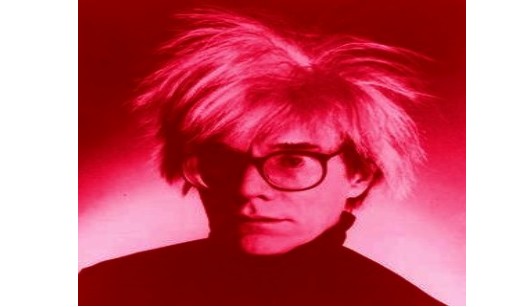 |
 |
| Hang
Him on my Wall
|
|
 |
|
--No
other artist is as much related with Pop Art as Andrew Warhola,
worldwide known as Andy Warhol... The Prince of Pop.
--For
many of you who still don't know this peculiar uniqueness of the
artist, Warhol loved cats and images of them can be found in many
of his artworks.
--One
of the artist's best friends described him as a committed workaholic.
--Nevertheless,
most importantly, for all of you concerned with the cause and
effect magic ( ...or chemistry... ) it's quality information to
state that Andy Warhol was truly and deeply obsessed by the ambition
to become very, very famous and incredibly wealthy.
--What
do you know!
--And
he was wisely aware enough of the price he had to pay in order
to achieve his goals.
--In
short, he always knew deep down inside that the fastest way in
order to achieve the so called American Dream, was through a breathtaking
process of highly intensive hard work. Fact.
--However,
one way or another, the truth is that the main turning point in
Andy Warhol's career which actually brought him fame, wealth and
success was way back in the early 1960s when the innovative and
daring artist began to make paintings of american products such
as Campbell's Soup Cans and Coca-Cola bottles, as well as comic
strips like Superman and Popeye.
--Also
in the very early 60s Warhol began making silk screens of celebrities,
namely Elvis Presley, Marilyn Monroe and Elizabeth Taylor.
--He
did his best and he did that using enlarging photographs plus
transferring the images onto his canvases using a projector.
--As
the result of this absolutely original form of Art, Ferus Gallery
in L.A. , California, exhibited his Campbell's Cans while in the
mean time in New York, Stable Gallery showed the Baseball, Coca-Cola
and the Do-it-Yourself Diagram paintings.
--New
York City, by then, was definitely meant to become his performing
stage.
--The
artist wasted no time and established a Studio at 47th street
in Manhattan, which became very popular and worldwide known as
The Factory. |
|
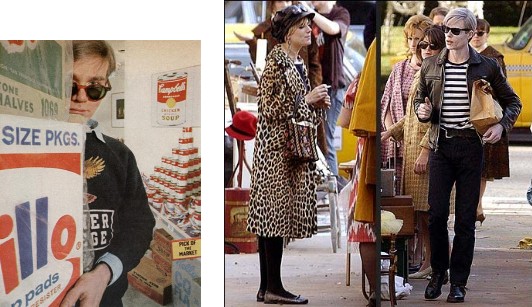 |
 |
| |
 |
| |
 |
--Therefore,
by then, the editorial reviews were breaking news!
Inside Andy Warhol's studio, a ramshackle place, meaning The Factory,
the post-war Art World encountered the industrial revolution.
--For
more than two years, Nat Finkelstein was on the Scene, documenting
the explosive emergence of... Pop Art!
--Pop
Art, indeed a subversive spectacle created by the constantly calculating
Andy Warhol.
--The
Factory years was an extraordinary photographic account of the
twisted, the addicted, the nameless... and ... THE FAMOUS!
--As
a member of the club, Finkelstein discreetly captured icons in
the making, including Bob Dylan, Lou Reed, Allen Ginsberg, Eddie
Sedgwick, along with such legends of another era as Salvador Dali
and Marcel Duchamp, and of course, Warhol himself.
--Engagingly
sequenced by renowned design firm Pentagram, Andy Warhol; The
Factory years features Finkelstein's seminal black-and-white photographs,
in addition to several series of previously unpublished colour
photographs that were thought lost for the past three decades.
--Finkelstein
accompanies these striking images with vivid memories, poetic
recollections, and acerbic commentary, providing both visual and
intellectual insight into the culture of The Factory.
--In
1964, while attending a party at The Factory, Finkelstein met
Andy Warhol, who had seen his 1962 Pageant magazine photographs
of a Claes Oldenburg happening in Greenwich Village.
--Intrigued
by the Scene, Finkelstein offered his services and for the next
three years was a constant presence at The Factory, whose activities
he recorded in four books.
--As
the house photographer for The Factory from 1964 to 1967, Finkelstein
created spontaneous portraits not only of Factory regulars like
Sedgwick and Gerard Malanga, but also of the artists and celebrities
who drifted in and out of the Warhol orbit.
--Billy
Name, another Factory fixture, was also producing photos at this
time.
--He
was on hand when Warhol presented Bob Dylan with one of his Elvis
"Flaming Star" silk-screen portraits, and took pictures
of Allen Ginsberg and Salvador Dali.
--He
captured Sedgwick and Nico, of the Velvet Underground, at their
most glamorous, and photographed the first Velvet Underground
performances and recording sessions. |
 |
 |
 |
| |
 |
--In
addition to painting and creating Box Sculptures such as Brillo
Box and Heinz Box, Andy Warhol began working in other mediums,
including record producing ( The Velvet Underground ), magazine
publishing ( interview ) and filmmaking.
--Andy
Warhol's avant-garde films such as Chelsea Girls, Blow Job and
Empire, have become classics of the underground genre.
--Warhol's
Factory was an Art Studio where he employed in a rather chaotic
way " art workers " to mass produce mainly prints and
posters but also other items like shoes designed by the artist.
--The
Factory included a wide range of artists, writers, musicians and
underground celebrities.
--Artists
like Andy Warhol were attacked by critics for "capitulating"
to consumerism.
--Critics
were scandalized by Warhol's open embrace of market culture.
--This
symposium set the tone for Andy Warhol's reception - though throughout
the decade it became more and more clear that there had been a
profound change in the culture of the Art World, and that Warhol
was at the center of that shift. |
 |
| |
 |
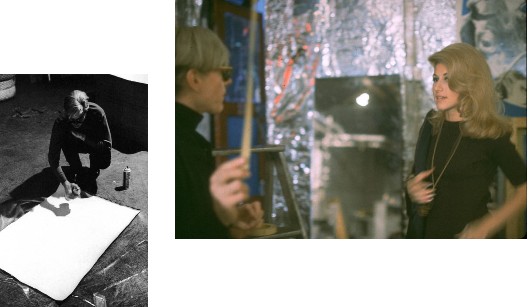 |
 |
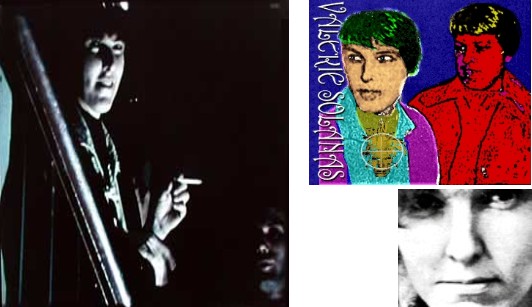 |
 |
--Valerie
Jean Solanas was an american radical feminist writer, best known
for her attempted murder of Andy Warhol in 1968.
--Solanas
arrived in Greenwich Village ( Manhattan ) in 1966, where she
wrote a play titled ...mmm...
"Up Your Ass" ...well ...about a man-hating prostitute
and a panhandler.
--In
1967, she encountered Andy Warhol outside his studio, The Factory,
and asked him to produce her play.
--Intrigued
by the title, he accepted the script for review.
--According
to Factory lore, Andy Warhol, whose films were often shut down
by the police for obscenity, thought the script was so pornographic
that it must be a police trap.
--He
never returned it to Solanas.
--The
script was then lost, not to be found until after Warhol's death,
in the botton of one of his lighting trunks. |
 |
| |
 |
--Later
that year, Solanas began to telephone Warhol, demanding he return
the script of "Up Your Ass".
--When
Andy admitted he had lost it, she began demanding money as payment.
--Warhol
ignored these demands but offered a role in "I, a Man".
---
"I, a Man " ( 1967) is a Andy Warhol film featuring
Warhol Superstars Tom Baker, Ivy Nicholson, Ingrid Superstar,
Cynthia May, Bettina Coffin, Ultra Violet, Nico... and, of course,
Valerie Solanas.
--Solanas
appeared in the film as compensation for the script she had given
to Warhol which he had lost.
--In
his book Popism ( The Warhol Sixties ), Andy wrote that before
she shot him, he thought Valerie Solanas was an interesting and
funny person, but that her constant demands for attention made
her difficult to deal with and ultimately drove him away.
--Andy
Warhol did give Solanas a role in a scene in his film " I,
a Man".
--In
that film, she and the film's title character, played by Tom Baker,
haggle in an apartment building hallway over whether they should
go into her apartment.
--Solanas
dominates the improvised conversation, leading Baker through a
dialogue about everything from "Squishy Asses" , "Men's
Tits ", and Lesbian instinct.
--Ultimately,
she leaves him alone by himself, explaining " I gotta go
beat my meat " ... as she exits the scene. |
 |
| |
 |
--On
June 3, 1968, Valerie Solanas arrived at The Factory and waited
for Andy Warhol in the Lobby area.
--When
she arrives with a couple of friends, she produced a handgun and
shot at Warhol three times, hitting him once.
--She
then shot art critic Mario Amaya and also tried to shoot Warhol's
manager, Fred Hughes, but her gun jammed as the elevator arrived.
--The
actress Viva was on the phone with Andy Warhol, whose pop celebrity
she was, when she heard loud cracking sounds coming through the
receiver.
--With
some justification, Viva kinkily thought "it was a whip cracking",
she said later...
--...But
she was hearing gunshots.
--Yes,
aspiring writer-actress Valerie Solanas had walked into The Factory.
---
The downtown Manhattan headquarters for Warhol´s Pop Art
Empire, Solanas pulled a 32 from the pocket of her trench coat
and... blazed away!
--Wounded
in the spleen, stomach, liver, lungs, and oesophagus, Andy Warhol
was given a 50-50 chance to live.
--And
so, on June 3, 1968, began the greatest scandal on the career
of the man who made an Art form of that genre. |
 |
| |
 |
--Ultra
Violet, Viva, and other Warhol-made superstars, gathered at Columbus
Hospital and speculated on Valerie Solana's motive for shooting
the artist.
--The
founder of SCUM ( Society for Cutting Up Men ), Solanas had appeared
as a Lesbian in Warhol's 1967 underground film, " I, a Man
", but she had always been on the outskirts of his circle.
--Reportedly,
she was angry because Warhol wouldn't film an obscenely titled
script she had given.
--Ultra
Violet said at the hospital "this underground movie world
is a mad, mad world with a lot of mad people in it. Maybe this
girl was mad herself ".
--Some
people thought there was no MAYBE about it.
--Surrendering
later that day to a cop in Times Square, Solanas said "the
police are looking at me. They want me. I am a flower child. He
had to much control over my life".
--At
her arraignment, Solanas stated, "It's not often that I shoot
somebody. I didn't do it for nothing". |
 |
| |
 |
--Warhol
spent two months in the hospital but didn't press charges.
--Solanas
copped a plea to first degree assault, was sentenced to three
years in prison, and became something of a heroine among fringe
feminists.
--After
serving her time, she lived quietly in New York, Phoenix, and
San Francisco, where she died in 1988 at the age of 52.
--She
survived by a year the man who became the very symbol of an age,
the omnipresent silver-bewigged demiurge of the demimonde, the
Pop Art pet of café society. |
 |
|
 |
| |
 |
--After
this assassination attempt, the Pop artist made a radical turn
in his process of producing Art.
--The
phylosopher of Art mass production now spent most of his time
making individuals portraits of the rich and affluent of his time
like Mike Jagger, Michael Jackson or Brigitte Bardot.
--Andy
Warhol's activities became more and more entrepreneurial.
--He
started the magazine Interview and even a night-club.
--In
1974 The Factory was moved to 860 Broadway.
--In
1975 Warhol published "The Phylosophy of Andy Warhol".
In this book he describes what Art is. "Making money is Art,
and working is Art and good business is the best Art."
--Though
best known for his earliest works - including his silk-screen
image of a Campbell's soup can and a wood sculpture painted like
a box of Brillo pads - Andy Warhol's career included successful
forays into photography, movie making, writing and magazine publishing.
--So
he founded Interview magazine, and in recent years both he and
his works were increasingly in the public eye, on american and
international magazine covers, in society columns and in television
advertisements for computers, cars, cameras and liquors.
--In
all these endeavours, Andy Warhol's keenest talents were for attracting
publicity, for uttering the unforgettable quote and for finding
the single visual image that would most shock and endure.
--That
his Art could attract and maintain the public interest made him
among the most influential and widely emulated artists of his
time.
--To
say that Andy Warhol "used people", seems at once accurate
and unfair. More to the point, he gave thrilling permission to
a lifelong parade of extroverts, from whose emotional demands
he then predictably shrank.
--His
ruling passion was a don't - touch - me drive for security, symbolized
by an ability to make things happen ... and lots of money!
--However,
Andy Warhol's jealous autonomy explains the one big failure of
his career.
--An
inability to make his extraordinary comprehension of the media
( film, television, rock music, publishing, on and on ... ) really
count in the entertainment industry, whose corporate instincts
rebuffed his requirement of total license.
--A
late-70's meeting with Lorne Michaels, an NBC producer, onlines
a prime-time Warhol television show.
--The
meeting, at which Andy Warhol minions did most of the talking,
seemed smashingly successful until "Andy got up and left
the room without a word".
--Andy
Warhol could not stand paternalism in any form. Willy-nilly, then,
and rather despite himself, Warhol was a type of the heroically
independent modern artist pitted against the homogenizing bourgeoisie.
--This
was the hidden term - a secret virtue, like his religion - in
his incredible triumph as an artist. |
 |
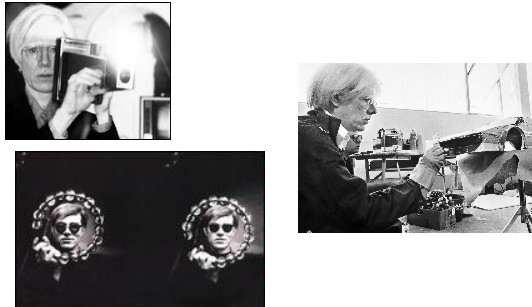 |
 |
| |
 |
| --Compared
to the success and scandal of Andy Warhol's work in the sixties,
the seventies proved a much quieter decade, as the artist became
more entrepreneurial.
--Andy
Warhol devoted much of his time to rounding up new, rich patrons
for portrait commissions - including Shah of Iran, Mohammad Reza
Pahlavi, his wife Empress Farah Pahlavi, his sister Princess Ashdaf
Pahlavi, Mick Jagger, "BB" Brigitte Bardot, Lizza Minnelli,
John Lennon and Diana Ross.
--Andy
Warhol's famous portrait of chinese communist leader Mao Zedong
was created in 1973. He was also founded, with Gerard Malanga,
Interview Magazine.
--Andy
Warhol used to socialize at various nightspots in New York City,
including Max's Kansas City, Serendipity 3 and, Studio 54.
--He
was generally regarded as a quiet, shy and a meticulous observer.
--Art
critic Robert Hughes called him "The White Mole of Union
Square."
--Andy
Warhol moved his studio superstar social club to Union Square
West, across the street from Max's Kansas City. The new location
had large shoes to fill. The former Factory was known for its
orgies, rampant drug abuse, and spectacular art collection.
--Warhol
decided to make the Back Room at Max's his home away from home.
A place of respite for himself and his superstars. Andy Warhol
made famous the completely neglected Back Room which was known
for its Blood Red ambiance.
--In
one corner was a Big Dan Flavin fluorescent sculpture, which bathed
the room in a reddish light, earning it the nickname "Bucket
of Blood". In the opposite corner was the round table, a
black vinyl banquette. Like the Round Table at Camelot, this table
ruled the roost.
--This
is where Andy Warhol sat! |
 |
|
 |
--Andy
Warhol and his entourage called "The Bucket of Blood",
home. It became a safe-haven for the artists, musicians, addicts,
models and ...IMPORTANT PEOPLE !
--It
was exciting but anonymous.
--Jim
Morrison could gently nod into oblivion behind his shades, sitting
with Nico without anybody asking for autographs. Even Janis Joplin
was treated like a Lady.
--So
the Pop Art Scene dines with Andy Warhol in the Back Room at Max's
Kansas City.
--Andy
Warhol's complete disregard for the establishment helped him rise
to the top in the New York Art Scene.
--The
Factory was Warhol's artistic home where he created his mass-produced
experiments with american iconography and codified Pop Art.
--Max's
Back Room was his very own social club where he and his cohorts
created a notorious social scene that came to define the seventies.
--There
was the ordinary heterosexual crowd and then you had the Warhol
crowd, which was kind of a pioneer, and later in the seventies
became so prevalent.
--It
became the rock style!
--In
the mean time, Andy Warhol guides the Velvet Underground to the
stage. Soon after christening his new Factory and taking over
the Back Room at Max's, Andy Warhol began to reach for new creative
outlets, namely a new band famous for their car-splitting feedback,
light-shows and dancers.
--Andy
Warhol had begun to expand his activities from paintings and lithographs
to include very peculiar movies and even a stranger rock band,
The Velvet Underground.
--Besides
vocals like Lou Reed and Nico, the band features a whip dance
by Gerard Malanga and a fantastic light show.
--The
Velvet Underground was almost entirely a Max's phenomenon. It
was there that the Velvets got their start playing as the house
band, it was there they could meet Brian Epstein - the man who
discovered The Beatles, and guided them to mega-stardom - through
plumes of marijuana smoke in his limo, and it was there at Max's
that they would play their final Live Performance with Lou Reed,
immortalized on their Live at Max's Kansas City record.
--The
Back Room is the place where Lou Reed said "Hey babe, take
a walk on the wild side".
--Lou
Reed's "Walk on the Wild Side" pays homage to the Warhol's
drag queens who came from rural America in search of fame.
--Lou
Reed's song about drugs, transsexuality, prostitution, and oral
sex, paints a vivid picture of the "girls" who made
Max's their home.
--Years
before the Stonewall Rebellion, the attitude at Max's was permissive
toward gender and sexual role experimentations.
--In
the sixties, there weren't a lot of places that let drag queens
in, but Max's did. You'd be in the ladies' room primping, and
Jackie Curtis and Holly Woodlaw would be in there with you putting
on their makeup, chatting and carrying on like women do about
their menstrual cramps and what-not.
--You'd
forget. It was like talking to one of the girls! |
 |
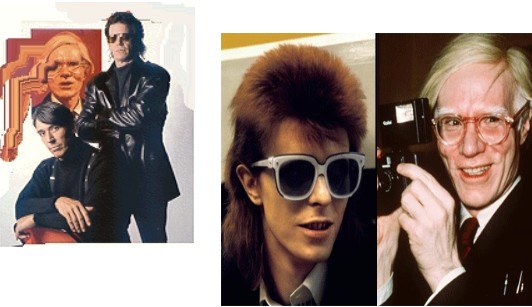 |
 |
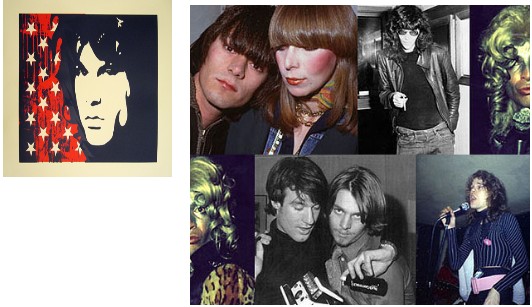 |
 |
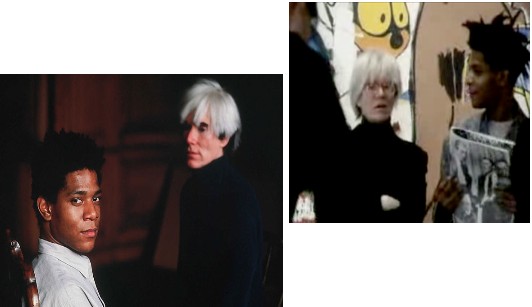 |
 |
--Like
other stars discovered at Maz's Jean Michel Basquiat, defined
a new genre of Art and expression.
--Andy
Warhol admired Basquiat for his ability to paint the grime and
grit of New York City street culture........
--Basquiat admired Warhol for his ability to make him famous.
--The
two formed an unrivalled relationship that dominated the Art world.
--It
was historic. Never before had Andy Warhol teamed up with another
this intimately.
--People
wondered aloud whether Warhol was using Basquiat, whether Basquiat
was using Warhol. None of that mattered.
--What
mattered was the fact that people were talking.
--On
the cover of magazines, on television, in the paper.
--Basquiat
became a member of Andy Warhol's entourage and quickly joined
the ranks of the round table.
--If
Andy Warhol was King, Basquiat was Prince, and the two reigned.
--Andy
Warhol is often described by those who knew him as complex figure
resistant to any type of analysis.
--He
acquired an image in the media for being the artist who never
spoke and who avoided interviews fervently.
--When
he decided to do them, friends say he would lie.
--He
is also said to have sent impersonators wearing wigs for his lecture
circuit.
--Andy
Warhol was so mysterious, people question the accuracy of his
birth date.
--When
Andy was born, there was no birth certificate issued. It wasn't
until 1945, when he went to college, that it was produced.
--Some
say Andy Warhol was obsessed with image and fame, and that he
influenced artists to pay as much attention to their appearance
as their work.
--Andy
Warhol had a very modern look and was often seen immaculately
dressed in a suit, with his tie askewed or his collar undone to
make his look unique.
--He
loved trendy things and tried to wear them before anybody else
could.
--Later
in his career, he was notorious for wearing black only. Since
black clothes tend to look alike, he would wear a rip in his pants
or do something that would indicate he wasn't always wearing the
same clothes.
--Whether
or not Andy Warhol consciously laboured over his appearance is
a topic of discussion that people disagree on.
--While
some say he was obsessed with looking good, giving beauty care
tips and filling his bags with endless supplies of cosmetics,
others say he deliberately tried to look good as bad as he could.
--Andy
Warhol was once quoted for saying "I play down my good features
and play up my bad ones. So I look awful and I wear the wrong
pants and the wrong shoes and I come at the wrong time with the
wrong friends, and I say the wrong things and I talk to the wrong
person, and then still sometimes somebody gets interested and
I freak out and I wonder ' What did I go wrong?'.
--Andy
began modelling for the Zoli agency, but many say this was an
endorsement of his celebrity status more than anything.
--If
Andy Warhol put his philosophy into his Art, he definitely put
his genius into his life!
|
 |
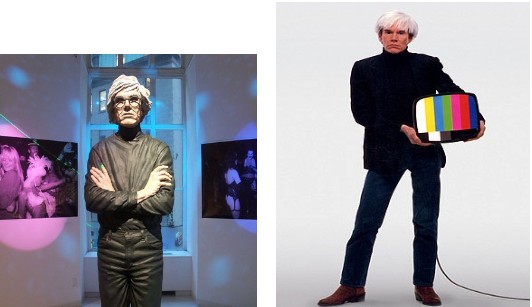 |
 |
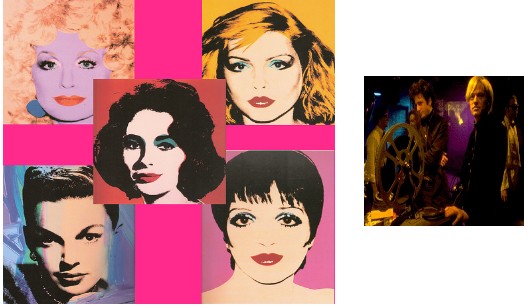 |
 |
|
|
|
|



